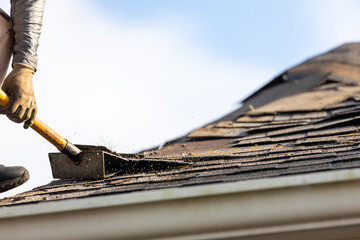Monthly Archives: July 2022
Things You Should Know Before Starting A Roof Shingle Project
If you’re considering having your roof reshingled, there are a few things you should know before starting. To estimate the price of your roof reshingle, you’ll need to factor in the rise, which is the rise in roof pitch per twelve inches of horizontal span. The rise can be as high as four inches per twelve inches, so you’ll need to use a multiplication factor of at least 1.06 to determine the total cost. Thankfully, the easiest way to determine the rise is to set a level against the rafters and measure up to the 12-inch mark. Contact Roof Reshingle experts if you are not sure where to start.

First, lay the starter course, which consists of three-tab shingles. Make sure that this course is at least one inch over the drip edge. It fills the gaps under the cutouts and joints of the next row of shingles. If your shingles have no overlap, use an adhesive to seal the tabs. This will prevent any leaks. Next, install the ridge cap. This will cover the entire roof.
When you begin a reshingling project, you should measure and mark the center of your roof. Start at the top and work your way down to the eaves. Most roofers use a vertical chalk line to mark the center and then work toward the rakes. Some shingle manufacturers recommend starting on the left edge of the rake. Regardless of which method you choose, make sure to measure the width of the roof and use a ruler or yardstick to get a clear idea of how much overlap there is.
Depending on the number of squares your roof covers, the reshingling process can cost between $400 and $500 per square. If you plan to have your roof reshingled to protect your investment, this process can save you a few hundred dollars or more. And the best part is, a good roof-reaching job will last fifteen to twenty years. So, it’s well worth the cost. And you’ll be happy with the results.
Before you begin the process, you need to remove your old roof. This is necessary to install new underlayment and flashing. Then, install the new shingles in overlapping layers from the ridge downward. Make sure to nail each new shingle into the course before it. Also, make sure to cut out any ridge caps and edging shingles. This way, you won’t have to tear off the entire roof.
Another reason to reshingle your roof is if the existing shingles have become cracked, brittle, or deteriorated. Most asphalt roof shingles are coated with oil during the manufacturing process, which means that they will dry out and look dingy over time. It’s also important to note that a reshingling job can be expensive, so make sure that you’re prepared for the price.
Another factor to consider is the shingle’s weight. The weight of your new roof reshingle will depend on the type and quality of your shingles. A three-tab shingle is lighter than architectural shingles, while slate tiles weigh the most. The weight of the shingles is also determined by the pitch of the roof. The pitch is the slope of the roof. If the shingles are flat, the slope will be more than 12 inches.
Before you decide on a roofing contractor, you should understand the roofing industry’s unit of measurement – the roof square. One roof square is equal to 100 square feet. It’s a useful measurement for comparing prices for shingles and installation costs. You should also know the difference between a square and a flange. It is easy to get confused between square and flange if you don’t understand these measurements.
Before installing the shingles, you should practice on a small section of the roof. Try not to roll out the entire roof until you’re completely confident. Try to install them in the same order as you did the first row of shingles. Make sure to staple the shingles with a nail or staple cap. Make sure to use nails and cap staples, especially if the slope is steep. This will prevent you from falling off the roof and injury.
If you’re a DIYer, you’ll probably opt for the inexpensive three-tab shingles. They’re strong enough to withstand up to 60 mph winds, but they’re not code-compliant. For that reason, you’re better off upgrading to better asphalt shingles, such as 30 or 50-year architectural shingles. These shingles can cost anywhere from $8 to $500 per square.